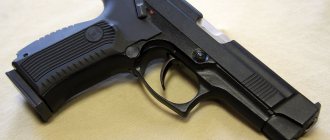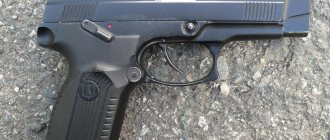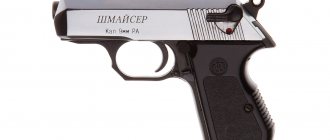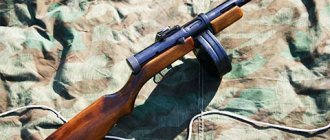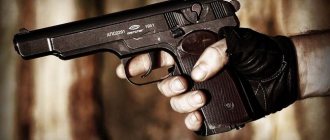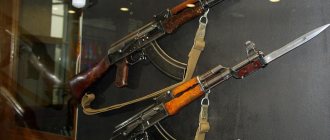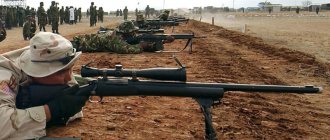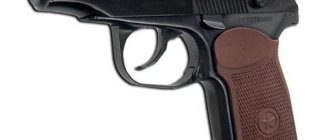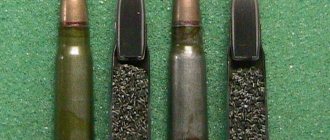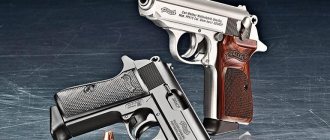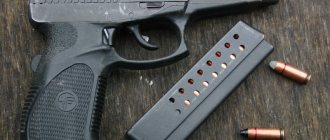Home | Weapons | Pistols | Russia / USSR | Yarygin PYa / Grach
The pistol, designed by Vladimir Aleksandrovich Yarygin, was created at the Izhevsk Mechanical Plant in accordance with the tactical and technical specifications of the competition for a new pistol for the army and law enforcement agencies, called “Rook”. The TTZ was formulated in January 1991 and subsequently changed several times. Work on the design of a new weapon began in 1993. Along with the pistol, a new cartridge was also being developed, which was supposed to surpass both the domestic 9x18 and NATO 9x19 cartridges in the penetration and stopping effect of the bullet. It was decided to focus on improving the 9x19 (9mm Parabellum) cartridge.
The automation works according to the scheme of using recoil with a short barrel stroke. Locking is carried out using the lowering breech of the barrel, which enters with its rectangular protrusion located above the chamber into the window for ejecting spent cartridges of the bolt-casing. The reduction occurs when the inclined surface of the internal groove in the breech boss of the barrel interacts with the axis of the bolt stop. The frame and bolt casing are made of carbon steel, and the barrel is made of stainless steel. The trigger mechanism is hammer-type, double-action with automatic safety cocking. The openly located trigger is covered from the sides by the rear part of the bolt-casing to prevent the trigger from getting caught on the shooter’s clothing or equipment when removing the weapon.
The trigger force when operating in self-cocking mode is 5.8 kg, and with pre-cocking the hammer - 2.6 kg. Such values are optimal for military weapons, providing sufficient safety when handling a loaded pistol. The double-sided safety levers are located on both sides of the frame, above the handle. When turned on, the hammer is locked in any of its positions, the trigger, the sear and the bolt-casing are blocked. The bolt stop lever is located on the left side of the frame. The ejector is also an indicator of the presence of a cartridge in the chamber.
The magazine latch, located on the left side of the frame, at the base of the trigger guard, can be easily moved to the right side. The box magazine holds 17 rounds with a double-row arrangement, as well as a double-row exit. Sights consist of a front sight and rear sight, fixed in a dovetail groove with the possibility of making lateral adjustments. The front and rear sights are equipped with white inserts to simplify and speed up aiming in low light conditions. The cheeks of the handle are made of plastic. The frame and bolt casing are made of carbon steel. The barrel is made of stainless steel by cold forging, and its bore is chrome-plated.
The 9×19 cartridge used in the PY is also of great importance. The main feature and advantage of the new cartridge, designated 7N21, is an armor-piercing bullet with a steel core protruding from the shell. As a result, the penetrating effect of the bullet increased significantly, which was the main requirement for the new cartridge. The bullet itself has a mass of 5.4 g, an initial speed of 450 m/s and an energy of 550 J. This cartridge can be used in any modern pistol of this caliber, and the PY, in turn, can shoot any other 9x19 cartridges.
The Tula Cartridge Plant and the Novosibirsk Low-Voltage Equipment Plant also produce cartridges with a bullet with a lead core, which have a lower cost than armor-piercing ones. Upon completion of the design work, the final version of the pistol was ready in 1995. Several experimental samples were made for the .40 S&W cartridge, popular in the USA, but they did not go into series due to the lack of large customers for such weapons in Russia. When debugging 40-caliber samples, problems arose with the reliability of feeding cartridges, but they were solved by introducing a special part into the design - a movable feeder.
After much work on possible design options, numerous improvements and modifications, the finished pistol at IZHMEX-e received the name MP-443, and MP should be read as Latin letters, which are short for Mechanical Plant. However, for official testing, the weapon was assigned the index 6P35. At the research site of the Russian Ministry of Defense, the pistols were tested for service life, reliability of operation in normal and difficult conditions (shooting without lubrication, at a temperature of - 50 to + 50 degrees Celsius, in dusty conditions, in rain). In total, about 1,500 shots were fired during such tests.
The PYa has demonstrated compliance with most of the stringent requirements of the RF Armed Forces. FSB officers highly appreciated the fighting qualities of the Yarygin sample. The tests were successful and the pistol was given the name PYA (Yarygin Pistol), under which it was adopted by the Russian army and law enforcement agencies in 2003. However, financial difficulties do not allow for full-scale rearmament and only a few elite units of the Armed Forces and special forces of the Ministry of Internal Affairs, FSB and GRU are equipped with Yarygin pistols. On October 9, 2008, the Ministry of Internal Affairs of the Russian Federation began to systematically replace Makarov pistols with PYa. But, again, taking into account problems with financing and the huge number of PM used by existing employees and stored in warehouses, rearmament is proceeding at a slow pace.
Like any weapon, the PY has both disadvantages and advantages. The angular handle is not comfortable enough to hold. The manually operated safety makes the weapon difficult to handle, but with regular training it does not cause any problems. The trigger, which is closed on the sides and does not have a safety release lever, cannot be moved to the forward position manually. This makes handling the weapon very difficult. A significant disadvantage of the design is the lack of a safe decocking function, which has become an almost mandatory element of the design of any modern combat pistols. The sights, made in the manner of Western designs, are equipped with white dots. The front sight is made very wide. This was supposed to speed up aiming, but had a very negative impact on shooting accuracy. In general, many of those who had experience shooting from PYa noted mediocre shooting accuracy at a distance of 25 meters. But this applies, as a rule, to pistols of early release.
The PY's slide-casing is quite high and massive, which is why the center of mass of the pistol, when held, is perceived as being higher than the hand and there is a tendency for the weapon to “collapse.” The pistol is bulky, heavy and has a considerable width. The latter circumstance greatly impedes concealed carry, and the large mass burdens the owner if the weapon is carried constantly. The trigger has a long trigger stroke, but at the same time, the stroke is quite smooth. Users noted problems with operational reliability when using cartridges from the Barnaul Machine Tool Plant, despite the fact that the pistols always worked perfectly with cartridges from the Tula Cartridge Plant. Currently, there are no problems with Barnaul cartridges due to their increased quality. Inconvenient incomplete disassembly, in comparison with the same PM or Glock, not to mention complete. The disadvantages include the lack of grooves for attaching tactical flashlights and laser lasers. The guaranteed firing rate of a PY is 4000 rounds, which is simply unacceptable by modern standards.
History of creation
The creation of the pistol began at the very beginning of 1991, when the Ministry of Defense of the Soviet Union formulated the main points of the task. The new weapon was supposed to replace the aging Makarov pistol, which was used as a service weapon in many law enforcement agencies.
Design work was carried out at several enterprises, among which were the Izhevsk Arms Plant, the Institute of Precision Engineering (TsNII TOCHMASH), located in the city of Klimovsk, and the Tula design bureaus of arms factories (TsKIB SOO and Instrument Design Bureau). The project was called "Rook".
As a result of this work, three versions of the pistol were born, using PMM, 9*18PM, and the old 7.62*25 TT cartridges. One of the experimental models was developed by designer V.A. Yarygin. By this time, the USSR had ceased to exist, and the further development of the pistol began to be supervised by the Russian Ministry of Defense. It was then that an addition to the design specifications appeared, according to which the weapon was supposed to use a more powerful 9*19 Parabellum cartridge.
One of the additional advantages of a pistol chambered for such a cartridge was the possibility of export.
To meet the requirements of the 9*19 cartridge standard, a Russian version was developed under the designation 7N21. Corresponding modifications were also made to the structural elements of the pistols. This took almost six years, and only in 1998-99 comparative tests of four versions of the new weapon were carried out.
Two 6P35 from factories in Izhevsk and Klimovsk, as well as the SR1 pistol, later called “Gyurza” from the same Klimovsk factory and GSh-18 from Tula. The final victory was won by the modernized Yarygin pistol from Izhevsk, which in 2000 was declared suitable for mass production and use as an army service weapon.
Having received the internal factory code MP-443 “Grach” since 2003 under the designation “9-mm Yarygin pistol (PYa)” it is in service with various branches of the Russian military. Currently, there is a gradual replacement of old Makarov system pistols with new PYa. All combat and sports variants of the "Rook" are produced at the plant in Izhevsk.
Video - history of creation
According to the instructions, the pistol is designed to hit various targets located at a distance of up to 50 meters. The 9 mm caliber cartridge used ensures reliable penetration of body armor of the Zh-81 or Zh-86-2 models at distances of up to 25 meters.
Obtaining a weapons permit
In Russia, you can obtain a firearms permit if you have a hunting license (for a hunter), or for sport shooting (for athletes). The rest of the citizens of our country are prohibited from purchasing and owning short-barreled military weapons according to the law of the Russian Federation.
For self-defense, you can use traumatic models of pistols by obtaining a license and permission to carry, use and store these weapons in advance. To do this you need:
- attend (self-paid) training courses in handling a specific pistol, followed by passing an exam in theory and practice;
- issue a certificate (of the required sample) by passing a medical examination at the clinic (paid for independently);
- pay the state fee and present the receipt when applying for a permit at the police station;
- prepare a photo size 3x4 (2 pcs.), and a copy of your passport;
- buy an appropriate (metal) safe with reliable locks where the pistol and ammunition will be stored (in a compartment isolated from the weapon and locked);
- Having collected all the above documents, come to the police department (LRO department) at your place of residence with an application for a permit.
Upon receipt of the necessary document (the license is issued in two weeks), you should monitor the validity period (for five years). Three months before the expiration of the license, it is necessary to contact the police in advance for a timely renewal of its validity. For an expired license, the law of the Russian Federation establishes a fine.
You should know that for violations of the required storage conditions of an LLC, the owner, according to the law, faces a fine of up to 2,000 rubles. or license revocation for up to two years. The owner of the weapon may even face imprisonment if, through his fault (due to improper storage of the pistol), an accident occurs that results in the death of a person.
Citizens under 21 years of age will be denied a special permit to use LLC in Russia, according to the law of the Russian Federation.
Scheme of work
The functionality of the mechanics of the PYa pistol is based on the use of part of the energy accumulated when the bolt moves backward. When fired, the powder gases eject the bullet through the barrel and at the same time force the bolt to move back through the bottom of the cartridge case. Another feature of the mechanical functionality was the use of a short-stroke barrel.
To reverse the shutter, a return spring is used that works in compression.
The spring is installed under the barrel on a separate rod. The barrel is connected to the bolt using a coupling located on the leading edge of the cartridge case reflector window. In total, the PY includes 29 parts.
Thanks to such a simple design, partial disassembly of the Yarygin pistol is quite simple and does not require any tools.
The operating sequence of the Yarygin system pistol mechanism is as follows:
- The movement of the trigger releases the hammer from the sear, which actuates the firing pin.
- The firing pin ignites the primer.
- The bullet is ejected along the barrel, while the bolt moves in the opposite direction and drags the barrel along with it.
- After passing through a short stroke, the pistol barrel is disconnected from the bolt body, which moves further, compressing its own return spring. The parts are separated by a separate cam on the coupling body.
- An empty cartridge remains in the bolt, which will be ejected at the moment of contact with the reflector before the end point of its movement.
- At the rear point, the bolt places the trigger in the firing position and begins to move back under the influence of a compressed spring. In this case, the bolt takes a cartridge with a bullet from the top of the magazine and sends it into the chamber located in the back of the barrel. At a certain point, the bolt comes into contact with the barrel, and together they reach the extreme forward point.
- At this moment, the engagement is triggered, the barrel bore is locked, and the pistol is again made for the next shot. To teach the techniques of disassembling and the order of assembling the Yarygin pistol, there is a special series of posters that very clearly show all the manipulations with the weapon. Based on this literature, training is carried out on the material part of a pistol in military schools and in advanced training courses for law enforcement officers.
Specifications
Thanks to the new ammunition, it was possible to increase the maximum sighting range of the pistol to 100 meters (option for the 9*21 cartridge). Compared to the previous model of the pistol, it was possible to reduce the recoil of the weapon and the displacement of the barrel from the aiming axis when firing.
Yarygin's pistol far surpassed the PM in its tactical and technical characteristics. To increase shooting accuracy and durability of the weapon, the inside of the barrel is coated with chrome.
According to the operating manual, the dispersion of bullets when firing from a Yarygin 6P35 pistol at a distance of 25 meters should not exceed 150 mm.
The pistols were equipped with two types of magazines. Early releases used a 17-cartridge configuration. Since 2004, the number of cartridges in the clip has been increased to 18. An experienced shooter can fire up to 35 bullets per minute from the PY. The pistol uses cartridges equipped with two types of bullets:
- With a standard carbon steel core, PS cartridge (7N21).
- With a carbide core with increased penetration characteristics, cartridge PNB (7N31).
The main parameters of the PU are given in the table.
| Length, mm | 198 |
| Height, mm | 145 |
| Empty weight, g | No more than 950 |
| Barrel length, mm | 112,5 |
| Number of rifling in the barrel, pcs | 6 |
| Bullet speed at exit from the barrel, m/sec | 340 |
New recruit "Yarygin". Yarygin pistol (6P35)
The previous issue of KALASHNIKOV described in detail the history of the implementation of the Grach design and development work, which ended on March 21, 2003 with the adoption of three 9-mm pistol systems by the RF Armed Forces. So, “Rooks” have become part of history, and pistol systems under their own names are just “fledged”. This article is dedicated to the first-born - the 9-mm Yarygin pistol (PYa), which, as a legacy of the “Rook” theme, rightfully received the index 6P35.
The current year, 2003, has become a milestone in the history of the Izhevsk Mechanical Plant. In the 61st year since the founding of the enterprise, the first pistol of its own design was adopted into service with the RF Armed Forces. The designer of the PYa pistol, V. A. Yarygin, before participating in the Grach R&D project, was known only among sports shooters as the designer of custom IZH-34(M) and standard IZH-35(M) pistols. Undoubtedly, the experience of working on high-precision weapons served as the basis that helped V. A. Yarygin be the first to “bring to mind” (satisfy all the requirements of the TTZ) his pistol design. What is PY?
General view of the Yarygin pistol (YA), adopted by the Russian army and the ammunition used
Vladimir Aleksandrovich Yarygin
The automatic pistol operates on the principle of recoil with a short barrel stroke. Locking (unlocking) of the barrel bore is carried out by coupling (disengaging) the barrel coupling with the front plane of the window to reflect the cartridge case as a result of the interaction of the cam groove on the protrusion of the barrel coupling with the contactor during the rollback (rollback) of the bolt. The hammer-type trigger mechanism with an open hammer allows firing only single shots, both self-cocking and with pre-cocking. The safety of handling the pistol is ensured due to the presence of a double-sided safety catch that blocks the bolt and trigger mechanism both in the lowered and cocked positions, as well as due to the safety cocking of the hammer, which prevents the hammer from hitting the firing pin when the hammer falls and breaks during its cocking.
To eliminate the possibility of inertial pinching of the igniter primer sent into the cartridge barrel, the firing pin is spring-loaded.
The relative position of the pistol parts after all the cartridges have been used up. The shutter is in the rearmost position on the slide stop
The pistol is fed with cartridges from a double-row detachable box magazine. To visually determine the number of cartridges in the magazine, there are holes in its body. The pistol is supplied with 2 magazines.
Location of the holster with the pistol and the spare magazine in a separate pouch on the belt
The large capacity of the magazine for the powerful 9x19 cartridge initially does not imply quick and convenient reloading, however, like all “classmates”. After half the magazine is filled with cartridges, the force on the feeder becomes much more noticeable, because the magazine spring should prevent the next cartridge from being missed or skewed during feeding. The push-button magazine release is located at the base of the trigger guard and can be installed for both right-handed and left-handed people. After pressing the latch, the magazine falls out of the pistol handle under its own weight, which facilitates quick magazine changes.
The hammer is cocked, the pistol is off the safety, there is no cartridge in the chamber (the ejector does not protrude beyond the upper plane of the bolt). The plastic inserts on the rear sight and front sight of the pistol are clearly visible
Non-adjustable open sights consist of a rear sight and a front sight and, to ensure shooting at dusk, have the ability to install capsules with a phosphor. In the usual version, instead of capsules, white plastic inserts are used.
Bringing the pistol to normal combat is done by moving the rear sight (horizontally) and replacing the rear sight (vertically).
The arrow in the photo shows the combat stop of the barrel coupling
The pistol is brought into normal combat at a distance of 25 m. In this case, the aiming point is also a control point (CP). The pistol's operating manual establishes the following criteria when bringing it to normal combat: the dispersion dimension of four holes in the target must be less than the diameter of a 15-centimeter circle, and the deviation of the average point of impact (MAP) from the CT should not be more than 7.5 cm in any direction. Taking into account the slight decrease in the trajectory of bullets (3-4 cm at a distance of 50 m), during practical shooting, even with extreme values of these parameters, an average shooter confidently hits the “chest” target No. 4 at a distance of 50 m and the “height” target No. 8 at a distance of 100 m. The average accuracy of fire at a distance of 25 m according to the r50 criterion, estimated by three groups of 10 shots, is usually 3-3.5 cm, with a requirement of no more than 4 cm (R100 is usually 5-6 cm).
Extraction of a spent cartridge case or a misfired cartridge is carried out by a double-armed spring-loaded ejector mounted in a groove in the upper plane of the bolt in the middle of the rear edge of the window to reflect the cartridges.
When loading the pistol, the front end of the ejector protrudes beyond the upper plane of the bolt, acting as an indicator of the presence of a cartridge in the chamber, both visually and by touch.
Removing the bolt from the slide stop
To prevent the reflected spent cartridge case from falling behind the shooter's collar (when the bolt is not rolled back vigorously), the ejector tooth has a bevel, and, together with a rigid cartridge case reflector mounted on the frame closer to the left side, ensures that the cartridge case is reflected upwards and to the right.
Switching on the fuse. The magazine release button is clearly visible
After the cartridges in the magazine are used up, the magazine feeder acts on the protrusion of the locking flag, which plays the role of a bolt stop, which, rising, enters the groove on the left side of the bolt, preventing it from returning to the front position. To return the bolt to the forward position, it is necessary to press the locking flag downwards or, by disconnecting the empty magazine (replacing it with a loaded one) and, slightly pulling the bolt back, release it to the extreme forward position.
The procedure for incomplete disassembly of a pistol. 1. Remove the magazine from the frame by pressing the magazine latch. 2. Make sure that there is no cartridge in the chamber by inspecting the chamber. 3. Separate the contactor by pushing it out on the right side and removing it from the frame hole on the left side. 4. Separate the bolt with the barrel and the return mechanism, sliding them forward along the guide frames. 5. Separate the barrel with the rod and return spring from the bolt, moving the breech of the barrel down behind the bolt rammer. Assembly is carried out in reverse order.
The PYa has a modern appearance and in no way resembles the “ancestors” of the Colt M1911 or Browning HP. The shape of the handle and safety bracket allow shooting with two hands, including in army two-fingered mittens.
V. A. Yarygin’s “sports” past is visible when examining individual components and parts of the pistol. So, in my opinion, the design of the magazine latch is extremely complicated, and the presence of small springs, for example a sear, is also an attribute of a sporting weapon rather than a combat weapon. Nevertheless, the design works without breakdowns with an acceptable number of delays in shooting both in the African heat and in Arctic frost conditions, with tropical downpours and the maximum possible dust.
Undoubtedly, the design of individual parts (for example, a frame of an extremely complex shape) was “sharpened” for Izhmekha technology, and it is unlikely that any Russian arms factory would undertake the production of PYa. However, the design idea does not sleep, and the team of V. A. Yarygin prepared a modification of the PY with a polyamide frame, while significantly reducing the weight of the pistol and its cost.
| Chuck length, mm | 29,7 |
| Bullet length, mm | 17,8 |
| Bullet diameter, mm | 9,03 |
| Cartridge weight, g | 9,3 |
| Bullet weight, g | 5,3 |
| Core mass, g | 3,8 |
| Bullet shirt | polyethylene |
| Powder charge mass, g | ~0,45 |
| Brand of gunpowder | SEP 20/4.80 |
| Capsule | KV-26 |
| Average maximum pressure powder gases, Pmav., kgf/cm2 | £2900 |
| Accuracy when shooting at 50 m from a ballistic barrel, r50av., cm | £3,5 |
| Caliber | 9x19 |
| Ammo used | 7N21, 9 mm Para |
| Overall dimensions, mm | |
| - length | 210 |
| - width | 38 |
| - height | 145 |
| Store capacity, pcs. cartridges | 18 |
| Weight with magazine without cartridges, kg | £1,0 |
| Barrel length, mm | 112,5 |
| Number of grooves, pcs | 6, right |
| Initial bullet speed of 7N21 cartridge, m/s | 465 |
| Combat rate of fire, rds/min. | 35 |
| Warranty time, rds. | ³4000 |
To separate the plastic handle, use the sharp end of a cleaning rod to press out the axle
To complete complete disassembly after separating the pistol handle, it is necessary to remove the trigger parts and the magazine latch from the frame
The left photo shows the bevel on the ejector tooth. To remove the ejector, it is necessary to press the ejector bend with a cleaning rod and, lowering the ejector tooth down, remove the ejector from the socket (on the right)
Pistol bolt parts
a – adjusting pins for the mirror gap of the locking unit, b – chamfers to ensure supply from the left and right magazine recesses, c – groove for the ejector
Various variations and modifications
Based on the basic PYa "Grach" pistol, a so-called commercial version is produced under the designation MP-446 "Viking". The main difference between such weapons is the plastic frame, which makes the pistol lighter. The Viking uses a standard 18-round magazine. In 2013, a version of the PYa was created for the more powerful 9*21 cartridge, but it did not go into mass production.
In addition to the combat version of the pistol, sports and traumatic versions are produced. The sports version of the MP-446S “Viking” has a plastic frame, a modified sight and a 10-round clip. Currently, a modernized version of the MP-446C “Viking-M” is being produced. It differs in the installed Picatinny rail and sighting device from the Glock pistol.
The main elements of the sports version are fully consistent with the combat version of the PY.
For firing with special traumatic ammunition 10*23, the MP-472 “Vintuk” variant was created. The main external difference of such a weapon is the frame, made of blue plastic.
The pistol is equipped with a magazine with a capacity of 16 rounds. Since 2010, a pistol of the MP-353 model, which belongs to the OOP class of weapons, has been produced for firing traumatic ammunition of the .45 Rubber type.
Cartridges for PYa
The development of domestic 9x19 cartridges in the early 90s was necessary in order to increase and improve the level of resources of personal weapons intended for self-defense or attack. This standard corresponds to the dimensions of a NATO warhead:
- internal ballistics are completely identical;
- the cartridge is designed for sale in pistols - PYA, GSh-18;
- it is also suitable for submachine guns.
Currently, warheads are divided into two types:
- cartridge, the bullet has a steel core - 9x19 PS (7N21);
- a cartridge with a bullet with increased penetration - 9x19 PBP (7N31).
The PYa has convenient, capacious magazines for ammunition, which can hold 18 rounds of ammunition in two rows.
Weight and size models
Based on the external appearance of the PYa pistol, a pneumatic version of the MP-655K was created.
It has a standard 4.5 mm caliber for air guns and uses compressed gas for firing, supplied from a replaceable cartridge in the handle. This pistol has been produced since 2008.
For training, the LT-110ПЯ, equipped with a laser emitter, can be used.
The purpose of such versions is educational, training and recreational shooting at various types of targets. Both options in their appearance and weight correspond to a full-fledged one, so they are suitable for initial training in shooting and handling the Yarygin pistol.
Disadvantages of the model
As the pistol entered service, the negative aspects of the weapon began to appear. Many employees of the special forces of the Ministry of Internal Affairs, after the combat use of Yarygin’s pistol, criticized its uniform. The angular and wide handle turned out to be not very comfortable to hold. The edges of the magazines have a sharp shape and, for ease of use, they are subjected to slight “tuning” - rounding with a file.
The inspection holes in the magazine clip are located on the right side and to check the condition of the magazine you have to remove it completely. A much bigger disadvantage is that the cartridges get stuck when the automatic pistol is operating. But such cases were recorded for a short time and only with cartridges produced by the plant in Barnaul, and are associated with insufficiently accurate geometry of the cartridges.
Currently, such problems do not occur when shooting from a Yarygin pistol.
One of the big disadvantages of the PJ is the lack of a mechanism for safely decocking the hammer.
A poorly placed clip release button can be pressed accidentally. The pistol's warranty life is 4 thousand shots, which is extremely low by today's standards. The pistol is removed from the safety manually, which is not typical for modern models. It takes a little time to remove, but these precious fractions of a second in a combat situation can cost lives.
Weak sides
At the model approval stage, experts mainly noted the advantages of the new weapon. As experience in operating the “Grach” pistol, whose characteristics we became acquainted with, increased, its negative sides began to appear. Many employees of the special units of the Ministry of Internal Affairs, after the combat use of the PYa, criticized its uniform. According to them, due to the angular and wide handle, the weapon does not fit comfortably in the hand. Among the operational shortcomings are the sharp edges of the magazine, which are often ground off with a file for convenience. The magazine, which must be completely removed from the handle to check its condition, was also criticized.
If the above features are excusable, then the stuck cartridges when the automatic weapon is operating is a real problem. In fairness, it is worth noting that this shortcoming was recorded for a short time and only when using those cartridges that were produced in Barnaul. The cause of the problem was the insufficiently precise geometry of the sleeves. Currently, this drawback has already been forgotten.
Another important problem in the design of the Yarygin pistol is the inability to safely decock the hammer. Manually removing the safety, which takes up precious seconds, is considered bad manners for modern weapons, as is a resource of only 4000 shots. The clip release button was also criticized. It is located in such a way that pressing can occur involuntarily at any time.
Additional equipment and accessories
Optionally, the PYA is equipped with a special removable strap of the Weaver system for mounting various devices - sights or flashlights. Since 2011, under the barrel of the pistol it has been possible to install a flashlight to illuminate targets with a built-in laser target indicating system. The flashlight is mounted on a standard Picatinny rail.
There is no standard silencer for installation on the PYa pistol.
For normal carrying, a special holster for the Yarygin pistol is used, made of thick leather and having a cover for an additional clip. Optionally, a plastic holster, which is made by several manufacturers, can be used to carry the pistol.
For concealed carrying of pistols, holsters of various designs are used - shoulder holsters, for wearing on the belt and behind the back, and a number of others.
However, the heavy weight and dimensions of the PY prevent it from being carried concealed. When selecting a holster, it is necessary to check the year of manufacture of the weapon. On models after 2011 there is a bar under the barrel and a modified shape of the bolt in the area of the window for ejecting the cartridge case. Therefore, the shape of the holster is slightly different.
For storage in safes, a special plastic stand for Yarygin’s pistol is used, which has standard places for weapons, two clips and 36 or 42 rounds of ammunition.
Disassembly and assembly
Disassembly of the PY pistol can be partial or complete. The first option is used for inspecting, cleaning and lubricating weapons. Complete disassembly is necessary to clean the gun from heavy contamination, change lubricant and repair. It is usually performed after prolonged use of the weapon in difficult conditions.
When disassembling, the manufacturer recommends following these rules:
- Before starting work, it is necessary to study the device of the product in detail.
- When disassembling, do not use strong impacts or excessive force.
- This operation should be carried out on a clean mat, placing individual parts in the order of dismantling.
- Upon completion of assembly, you need to check the correct operation of the weapon without live ammunition.
- It is not recommended to disassemble the pistol too often.
